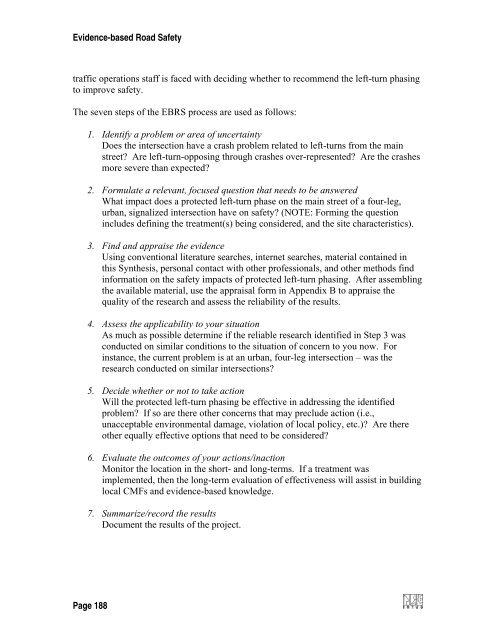Synthesis of Safety for Traffic Operations - Transports Canada
Synthesis of Safety for Traffic Operations - Transports Canada
Synthesis of Safety for Traffic Operations - Transports Canada
You also want an ePaper? Increase the reach of your titles
YUMPU automatically turns print PDFs into web optimized ePapers that Google loves.
Evidence-based Road <strong>Safety</strong><br />
traffic operations staff is faced with deciding whether to recommend the left-turn phasing<br />
to improve safety.<br />
The seven steps <strong>of</strong> the EBRS process are used as follows:<br />
1. Identify a problem or area <strong>of</strong> uncertainty<br />
Does the intersection have a crash problem related to left-turns from the main<br />
street? Are left-turn-opposing through crashes over-represented? Are the crashes<br />
more severe than expected?<br />
2. Formulate a relevant, focused question that needs to be answered<br />
What impact does a protected left-turn phase on the main street <strong>of</strong> a four-leg,<br />
urban, signalized intersection have on safety? (NOTE: Forming the question<br />
includes defining the treatment(s) being considered, and the site characteristics).<br />
3. Find and appraise the evidence<br />
Using conventional literature searches, internet searches, material contained in<br />
this <strong>Synthesis</strong>, personal contact with other pr<strong>of</strong>essionals, and other methods find<br />
in<strong>for</strong>mation on the safety impacts <strong>of</strong> protected left-turn phasing. After assembling<br />
the available material, use the appraisal <strong>for</strong>m in Appendix B to appraise the<br />
quality <strong>of</strong> the research and assess the reliability <strong>of</strong> the results.<br />
4. Assess the applicability to your situation<br />
As much as possible determine if the reliable research identified in Step 3 was<br />
conducted on similar conditions to the situation <strong>of</strong> concern to you now. For<br />
instance, the current problem is at an urban, four-leg intersection – was the<br />
research conducted on similar intersections?<br />
5. Decide whether or not to take action<br />
Will the protected left-turn phasing be effective in addressing the identified<br />
problem? If so are there other concerns that may preclude action (i.e.,<br />
unacceptable environmental damage, violation <strong>of</strong> local policy, etc.)? Are there<br />
other equally effective options that need to be considered?<br />
6. Evaluate the outcomes <strong>of</strong> your actions/inaction<br />
Monitor the location in the short- and long-terms. If a treatment was<br />
implemented, then the long-term evaluation <strong>of</strong> effectiveness will assist in building<br />
local CMFs and evidence-based knowledge.<br />
7. Summarize/record the results<br />
Document the results <strong>of</strong> the project.<br />
Page 188
















